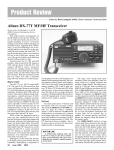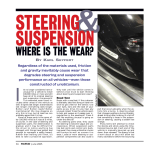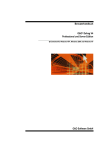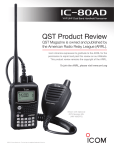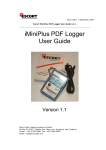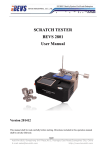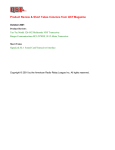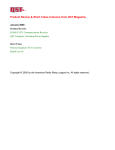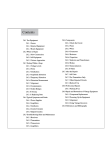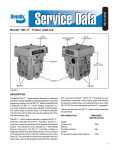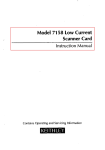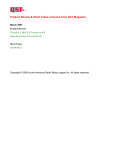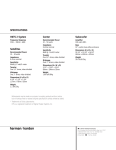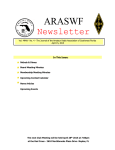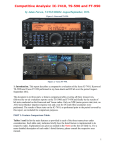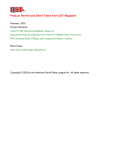Download Yaesu FT-847
Transcript
Product Review Column from QST Magazine August 1998 Yaesu FT-847 HF/VHF/UHF Transceiver ICOM IC-T8A Multiband Hand-held Transceiver Copyright © 1998 by the American Radio Relay League Inc. All rights reserved. Product Review Edited by Rick Lindquist, N1RL• Senior Assistant Technical Editor Yaesu FT-847 HF/VHF/UHF Transceiver Reviewed by Steve Ford, WB8IMY QST Managing Editor In the high-stakes poker game that characterizes the Amateur Radio industry today, Yaesu has significantly raised the ante with the debut of its FT-847 HF/VHF/UHF transceiver. For the first time in ham history we have a single radio that covers all HF bands plus the three most active VHF/ UHF bands right out of the box! (Yaesu’s earlier FT-767 offered similar capabilities but required optional modules—Ed.) This everything-in-one-box trend was pioneered several years ago when ICOM combined HF, 6 and 2 meters in a single rig and created the IC-706. It was an instant hit. Other manufacturers quickly followed suit with HF radios that also included 6 meters and, in some cases, 2 meters. In rolling out the FT-847 Yaesu has trumped the competition by adding 70 cm and satellite capability. The FT-847 certainly represents the state of the art in one-stop transceiver shopping. But how does this revolutionary rig really measure up? Let’s take a look. Styling, Ports and Controls The FT-847’s styling departs from the traditional “shoebox” look. This transceiver is sleek and dark with a low vertical profile. The ’847 is compact and fits easily on any desktop. It is a bit bulky for installation in smaller automobiles, but it should fit well in most sports utility vehicles and intermediate-sized cars. Unlike some mobile-friendly radios, however, the ’847’s front panel does not detach for remote mounting. An assortment of buttons and knobs crowd the front panel, but even my thick fingers could navigate this ergonomic forest with little difficulty. The FT-847 display is extremely bright and crisp (you can adjust the brightness through eight different levels). The blue-on-white characters are easy on the eyes, regardless of the viewing angle. For the visually impaired Yaesu has thoughtfully added the ability to verbally announce the frequency display through the use of the optional FVS-1A voice unit. To activate the FVS-1A, you simply press the front-panel VOICE button. Metering is incorporated into the left-hand side of the LCD display. There is an S meter, an FM discriminator meter, and a real RF power output meter calibrated in watts (not just a relative output meter). There is no SWR metering, something that’s become practically a staple in modern radios, but there is a HI SWR indicator on the display. When using the FT-847 with the optional ATAS64 August 1998 100 multiband mobile antenna system, the meter scale shows reflected power instead. The front panel controls include the usual suspects, such as concentric AF and RF gain knobs, RF power output, microphone level, receiver incremental tuning (labeled CLAR for “clarifier”), IF shift, and a numeric keypad. You’ll also find a control to adjust the CW keyer speed (a welcome improvement over rigs that hide this function in a menu system) and a set of concentric knobs and companion buttons for the DSP functions. The primary VFO knob is dead center on the panel. Concentric with this knob is the Shuttle Jog ring. You can make enormous frequency changes very quickly by grasping the ring and gently rocking it clockwise or counterclockwise. Think of it as a frequency “fast forward/reverse” control. At first, it seemed awkward, but I soon mastered the necessary movements. From that point onward, Shuttle Jog was the only way to fly! The MEM/VFO CH knob also permits quick frequency excursions according to the step size selected. One front-panel control that users remarked about was the single MENU button. This provides simple, quick access to the radio’s additional features. BOTTOM LINE Yaesu may have one-upped the competition with the FT-847. Here’s an all-in-one HF through UHF transceiver package that couples lots of features and reasonable performance across the board with a price tag that many hams will find hard to resist. You’ll find the headphone jack on the front panel, where it should be. The headphone jack requires a 1 /4 -inch plug. On the ’847’s rear panel you’ll find no fewer than four antenna jacks: HF, 6 meters, 2 meters and 70 centimeters. (The 70-cm jack is a female N connector; the others are SO-239s.) The menu lets you redirect 6-meter signals (transmit and receive) through the HF antenna port, eliminating the need for an external diplexer when using a combined HF/6-meter antenna. The FT-847 does not have an internal automatic antenna tuner, even as an option. Yaesu does offer the FC-20 external autotuner, however, for HF through 6 meters. Surrounded by the antenna jacks on the rear panel is a small cooling fan. There’s a second cooling fan near the front panel, and the two fans work in concert—what Yaesu calls a “push-pull” cooling system. These fans run continuously. Some reviewers complained that the fans were noisy, saying that it reminded them of a loud fan in a computer power supply. Others didn’t seem to mind the high-pitched whine at all. Like everything else, it boils down to a matter of personal preference. Among the other rear-panel jacks are separate ports (these are mini-DIN style jacks) for VHF/UHF packet (1200 or 9600 baud) and HF digital modes. The HF DATA IN/OUT data jack does double duty as the fixed-level audio output. The computercontrol port (CAT) is represented by a 9pin DB-9 jack. You do not need an external interface to connect the FT-847 to your computer, but you must use a null-modem cable rather than a straight serial cable. Convenient as this CAT function is, there is a substantial fly in the ointment. See the Table 1 Yaesu FT-847, serial number 8C020205 Manufacturer’s Claimed Specifications Measured in the ARRL Lab Frequency coverage: Receive, 0.1-30, 36-76, 108-174, Receive, 0.5-32(see text), 35-76, 108-174, 420-512 MHz; 420-512 MHz; transmit,1.8-2, 3.5-4, 7-7.3, 10.1-10.15, 14-14.35, transmit, as specified. 18.068-18.168, 21-21.45, 24.89-24.99, 28-29.7, 50-54, 144-148, 420-450 MHz. Power requirement: Receive, 2 A; transmit, 22 A (100W output). Receive, 2 A; transmit, 20 A. Tested at 13.8 V. Size (height, width, depth): 3.4×10.2×10.6 inches; weight, 14.4 pounds. Modes of operation: SSB, CW, AM, FM, AFSK. As specified. Receiver SSB/CW sensitivity, bandwidth not specified, 10 dB S/N: 1.8-30 MHz, <0.25 µV; 50-54 MHz, <0.2 µV; 144-148, 420-450 MHz, <0.13 µV. Receiver Dynamic Testing Minimum discernible signal (noise floor), 500 Hz filter: Preamp off Preamp on 1.0 MHz –129 dBm –134 dBm 3.5 MHz –131 dBm –137 dBm 14 MHz –131 dBm –136 dBm 50 MHz –134 dBm –140 dBm 144 MHz –140 dBm –142 dBm 432 MHz –139 dBm –141 dBm 10 dB (S+N)/N, 1-kHz tone, 30% modulation: Preamp off Preamp on 1.0 MHz 2.4 µV 1.2 µV 3.8 MHz 1.9 µV 0.8 µV 50 MHz 1.0 µV 0.6 µV 120 MHz 1.3 µV 0.5 µV 144 MHz 0.6 µV 0.4 µV 432 MHz 0.8 µV 0.5 µV For 12 dB SINAD: Preamp off Preamp on 29 MHz 0.7 µV 0.3 µV 52 MHz 0.4 µV 0.2 µV 146 MHz 0.2 µV 0.2 µV 440 MHz 0.3 µV 0.2 µV Blocking dynamic range, 500 Hz filter: Preamp off Preamp on 3.5 MHz 114 dB 109 dB 14 MHz 114 dB* 109 dB* 50 MHz 114 dB* 112 dB* 144 MHz 103 dB* 96 dB* 432 MHz 105 dB* 98 dB* Two-tone, third-order IMD dynamic range, 500 Hz filter: Preamp off Preamp on 3.5 MHz 92 dB 90 dB 14 MHz 95 dB 89 dB 50 MHz 89 dB 90 dB 144 MHz 88 dB 84 dB 432 MHz 85 dB 83 dB Preamp off Preamp on 3.5 MHz +6.1 dBm –0.5 dBm 14 MHz +12 dBm –0.7 dBm 50 MHz +0.9 dBm –5.5 dBm 144 MHz –11 dBm –19 dBm 432 MHz +2.6 dBm –6.5 dBm Preamp off, +12.4 dBm; preamp on, +14.7 dBm. 20 kHz channel spacing, preamp on: 29 MHz, 82 dB; 52 MHz, 80 dB; 146 MHz, 69 dB; 440 MHz, 68 dB. AM sensitivity, 10 dB S/N: 0.5-1.8 MHz, <20 µV; 1.8-30 MHz, <2 µV; 50-54 MHz, <1 µV. FM sensitivity, 12 dB SINAD: 28-30 MHz, <0.5 µV; 50-54 MHz, <0.25 µV; 144-148, 420-450 MHz, <0.2 µV. Blocking dynamic range: Not specified. Two-tone, third-order IMD dynamic range: Not specified. Third-order intercept: Not specified. Second-order intercept: Not specified. FM adjacent channel rejection: Not specified. 0 0 0 Reference Level: 0 dB PEP Reference Level: 0 dBc Reference Level: 0 dB PEP –10 –10 –10 –20 –20 –20 –30 –30 –30 –40 –40 –40 –50 –50 –50 –60 –60 –60 –70 –70 –70 –80 0 –80 –10 20 40 60 80 100 120 140 Frequency (MHz) 160 180 200 Figure 1—Worst-case spectral display of the FT-847 transmitter during spectral purity testing. Note the multiple spurs appearing just below the –40 dBc legal threshold for spurious emissions at full output power on this frequency. The transceiver was being operated at 100 W output at 28.0 MHz. –8 –6 –4 –2 0 2 4 Frequency Offset (kHz) 6 8 10 Figure 2—Worst-case spectral display of the FT-847 transmitter during two-tone intermodulation distortion (IMD) testing on HF. The worse-case third-order product is approximately 28 dB below PEP output, and the worse-case fifth-order product is approximately 51 dB down. The transceiver was being operated at 100 W output at 28.350 MHz. –80 –10 –8 –6 –4 –2 0 2 4 Frequency Offset (kHz) 6 8 10 Figure 3—Worst-case spectral display of the FT-847 transmitter during two-tone intermodulation distortion (IMD) testing on VHF/UHF. The worse-case third-order product is approximately 28 dB below PEP output, and the worse-case fifth-order product is approximately 46 dB down. The transceiver was being operated at 50 W output at 432.2 MHz. August 1998 65 FM two-tone, third-order IMD dynamic range: Not specified. S-meter sensitivity: Not specified. Squelch sensitivity: SSB, 0.5-1.8 MHz, <20 µV; 1.8-30 MHz, <2 µV; 50-54 MHz, <1 µV; 144-148, 420-450 MHz, <0.5 µV; FM, 28-30 MHz, <0.25 µV; 50-54 MHz, <0.2 µV; 144-148, 420-450 MHz, <0.16 µV. Receiver audio output: 1.5 W at 10% THD into 8 Ω. IF/audio response: Not specified. Spurious and image rejection: 60 dB. Transmitter Power output: HF & 50 MHz: SSB, CW, FM, 100 W (high); AM, 25 W (high); 144 & 420 MHz, 50 W (high); AM, 12.5 W (high). Spurious-signal and harmonic suppression: ≥40 dB on HF for harmonics, ≥50 dB for spurious; ≥60 dB on VHF & UHF for harmonics and spurious. SSB carrier suppression: ≥40 dB. Undesired sideband suppression: ≥40 dB. Third-order intermodulation distortion (IMD) products: Not specified. CW keyer speed range: Not specified. CW keying characteristics: Not specified. Transmit-receive turn-around time (PTT release to 50% audio output): Not specified. Receive-transmit turn-around time (tx delay): Not specified. Composite transmitted noise: Not specified. Bit-error rate (BER), 9600-baud: Not specified. Expanded Product Review Report Available The ARRL Laboratory offers a detailed test result report on the Yaesu FT-847 that gives indepth, technical data on the transceiver’s performance, outlines our test methods, and helps you to interpret the numbers and charts. The report even includes a summary of how this radio stacks up with similar, previously tested units. Request the FT-847 Test Result Report from the ARRL Technical Department, 860-594-0278; e-mail [email protected]. It’s $7.50 for ARRL members and $12.50 for nonmembers, postpaid. 20 kHz channel spacing, preamp on: 29 MHz, 77 dB; 52 MHz, 76 dB; 146 MHz, 69 dB*; 440 MHz, 68 dB*; 10 MHz channel spacing, preamp on: 52 MHz, 107 dB; 146 MHz, 89 dB; 440 MHz, 82 dB. S9 signal at 14.2 MHz: preamp off, 65 µV; preamp on, 20 µV; 52 MHz, preamp off, 45 µV; preamp on, 15 µV; 146 MHz, preamp off, 22 µV; preamp on, 9.1 µV; 432 MHz, preamp off, 39 µV; preamp on, 12 µV. At threshold, preamp on: SSB, 14 MHz, 0.5 µV; FM, 29 MHz, 0.2 µV; 52 MHz, 0.1 µV; 146 MHz, 0.1 µV; 440 MHz, 0.1 µV. 2.4 W at 10% THD into 8 Ω. Range at –6dB points, (bandwidth): CW-N (500 Hz filter): 121-902 Hz (781 Hz); CW-W: 130- 2135 Hz (2005 Hz); USB-W: 138-3103 Hz (2965 Hz); LSB-W: 160-3143 Hz (2983 Hz); AM: 110-2930 Hz (2820 Hz). First IF rejection, 14 MHz, 122 dB; 50 MHz, 54 dB; 144 MHz, 123 dB; 432 MHz, 84 dB; image rejection, 14 MHz, 95 dB; 50 MHz, 96 dB; 144 MHz, 97 dB; 432 MHz, 55 dB. Transmitter Dynamic Testing HF & 50 MHz: CW, SSB, FM, typically 107 W high, 1.5 W low; AM, typically 28 W high, 3 W low; 144 & 432 MHz: CW, SSB, FM, typically 50 W high, 1.5 W low; AM, typically 13 W high, 1.5 W low. HF, 41 dB (see Figure 1); 50 MHz, 63 dB; 144 and 432 MHz, 70 dB. Meets FCC requirements for spectral purity for equipment in its power output class and frequency range. As specified. >50 dB. As specified. >55 dB. See Figures 2 and 3. 10 to 41 WPM. See Figure 4. S9 signal, 12 ms. SSB, 12 ms; FM, 11 ms. Unit is suitable for use on AMTOR. See Figures 5 and 6. 146 MHz: Receiver: BER at 12-dB SINAD, 1.1×10–3; BER at 16 dB SINAD, 4.0×10–5; BER at –50 dBm, <1.0×10–5; transmitter: BER at 12-dB SINAD, 2.1×10–4; BER at 12-dB SINAD + 30 dB, <1.0×10–5. 440 MHz: Receiver: BER at 12-dB SINAD, 1.1×10–3; BER at 16 dB SINAD, 4.0×10–5; BER at –50 dBm, <1.0×10–5; transmitter: BER at 12-dB SINAD, 8.9×10–4; BER at 12-dB SINAD + 30 dB, <1.0×10–5. Note: Unless otherwise noted, all dynamic range measurements are taken at the ARRL Lab standard spacing of 20 kHz. *Measurement was noise-limited at the value indicated. Third-order intercept points were determined using S5 reference. –60 –70 –60 Reference Level: - 60 dBc/Hz Vertical Scale: dBc/Hz –70 –80 Figure 4—CW keying waveform for the FT-847 showing the first two dits in semibreak-in mode. The equivalent keying speed is 60 wpm. The upper trace is the actual key closure; the lower trace is the RF envelope. Horizontal divisions are 10 ms. The transceiver was being operated at 100 W output at 14.2 MHz. 66 August 1998 –80 –90 –90 –100 –100 –110 –110 –120 –120 –130 –130 –140 2 Reference Level: - 60 dBc/Hz Vertical Scale: dBc/Hz 4 6 8 10 12 14 16 18 20 Frequency Sweep: 2 to 22 kHz from Carrier 22 Figure 5—Worst-case tested spectral display of the FT-847 transmitter output during composite-noise testing on HF. Power output is 100 W at 3.5 MHz. The carrier, off the left edge of the plot, is not shown. This plot shows composite transmitted noise 2 to 22 kHz from the carrier. –140 2 4 6 8 10 12 14 16 18 20 Frequency Sweep: 2 to 22 kHz from Carrier 22 Figure 6—Worst-case tested spectral display of the FT-847 transmitter output during composite-noise testing on VHF/ UHF. Power output is 50 W at 432.2 MHz. The carrier, off the left edge of the plot, is not shown. This plot shows composite transmitted noise 2 to 22 kHz from the carrier. sidebar “The CAT’s Meow?” The rear panel also offers an ALC port, a PTT jack (in case you want to use a foot switch to key the rig), and an external speaker jack. Speaking of speakers, you’ll find one on the top panel. The audio is clear and smooth—among the best audio we’ve heard from a transceiver in a long time. The AF GAIN control acted a bit strangely, though. On all three units we looked at, there was no audio at all for the first quarter turn, at which point it sprang to life. Yaesu says it has addressed this problem in current production. Last but not least on the rear apron is the dc power connector (you must provide your own ac supply). Yaesu’s dc power cord, comprised of four, separate wires, did not make a favorable impression. At the very least, the whole assembly should have been secured with cable ties. It’s possible to install up to three optional Collins mechanical filters in the FT-847. A 500-Hz CW filter, the YF-115C, can be installed in the 455 kHz second IF. We purchased the optional CW filter. Since the radio is capable of full-duplex satellite operation, Yaesu offers optional SSB Collins mechanical filters for both receive and transmit to replace the stock ceramic filters in the second IF. Yaesu says the transmit filter should yield flatter, more natural-sounding audio. We did not install nor test these optional SSB filters, however. HF Performance The FT-847 generates 100 W output on 160 through 10 meters in the CW, SSB and FM modes, and 25 W on AM. In the HF range, it also receives continuously from 100 kHz to 30 MHz, but in the ARRL Lab, we found that useful sensitivity actually begins around 500 kHz or so. In the “nice touch” department, we’d like to note that the FT-847 is the first amateur transceiver we know of that includes provisions to transmit on the Alaska emergency communications frequency of 5167.5 kHz. Operation is straightforward and intuitive. I had it on the air the first time in under a minute without referring to the manual. You simply plug in the hand-held microphone (supplied), push the POWER button, push the button for your favorite mode (SSB, FM, AM or CW), turn up the microphone and RF gain controls as necessary, select your frequency, and you’re all set! Audio reports on the voice modes were excellent, even when running the speech processor. By pressing the MONI button you can listen to melodious sound of your own voice in your headphones. This is a neat feature that you usually find only on more expensive radios. (When you’re using too much speech compression, you’ll know right away!) The missing element, puzzling as it may seem, is the voice-activated switch or VOX. Not all operators will bemoan the lack of a VOX, but DXers and contesters certainly will. (On the other hand, the ’847 does have a MOX—manually operated switch—which is convenient when testing or making adjustments.) Yaesu says it considered including VOX but decided against it because of the FT-847’s primary application as a satellite radio. The built-in electronic keyer acquitted itself well on CW, although the keyer speed shifts quite a bit with just minor movements of the front-panel control. This makes it difficult to set the speed exactly where you want it. The keyer does not have any message buffers (memories). The ’847 doesn’t support full break-in either. You can set the T/R delay to as little as 10 ms, but that’s as close as you’ll get to QSK, and then you’ll have to put up with the clattering of the T/R relay (the maximum delay is 300 ms). On CW, the MONI button enables or disables the sidetone. One terrific feature for CW fans is the spotting function. Even newbies can use this tool to easily and accurately zero beat with the stations they intend to call. It’s sometimes amazing how many CW QSOs you’ll still find where stations are sometimes hundreds of Hertz apart because of faulty zero beating. This can be annoying, especially if there are more than two stations on frequency. It also means the QSO is taking up more room on the band than it needs to. On RTTY and PACTOR I, the FT-847 turned in a good performance. Transmit/receive turnaround was more than sufficient for excellent long-distance PACTOR operating. The ’847 does not offer an FSK mode with narrow filters; this is strictly an AFSK rig. But with the DSP filters you can narrow the audio bandwidth considerably. This isn’t as desirable as having a narrow filter in the IF, but it is acceptable for all but the most crowded conditions. The FT-847 manual strongly advises against running full output in the RTTY mode. In fact, Yaesu recommends that you throttle the output down to about 50 W when operating RTTY. The FT-847’s overall HF reception is good, but not stellar. For the sake of comparison, the dynamic range numbers (both blocking and two-tone, third order IMD) of Yaesu’s FT-920 were slightly better on HF (see “Product Review,” QST, Oct 1997). The transceiver is sensitive enough for casual operating, and its selectivity is adequate in that respect as well. Under crowded band conditions (during a contest, for example), the ’847’s HF receiver showed its weakness. Nearby signals hammered the AGC, and it soon became obvious that ’847’s dynamic range characteristics were not up to the task. Then again, Yaesu isn’t marketing the ’847 as a contest radio. If it were a high-performance HF contest rig, you’d also expect to shell out quite a few more dollars for the pleasure of owning it. The FT-847’s transmit IMD performance on HF (see Figure 2) was quite good on most bands. The worst case was 10 meters, one of only two HF bands where the third-order IMD products poked above –30 dB (the other was 12 meters). Especially noteworthy, however, was the fact that third-order IMD products were down by around 40 dB on some lower bands, and fifth and higher-order products were sub- stantially down across the HF range—in all cases more than 40 dB and approaching 50 dB on 40 and 20 meters! Bird Watching One irritant our reviewers noticed was a proliferation of internally generated signals—“birdies”—on several HF bands. Birdies were audible even with the antenna disconnected. Fifteen meters was the worst. We suspected a problem with the particular ’847 we had purchased, so we bought another radio. No such luck. The birdies were present on the second rig as well, although they were not as prominent as they were on the first unit, and they were on different frequencies. In addition, we’d noted that both radios, while spectrally legal, did not meet Yaesu’s –50 dB specification for spurious and harmonic emissions and had numerous spurs (see Figure 1). The consensus was that we definitely had a problem, but its nature was not entirely clear. We’d bought our two FT-847s from different dealers and at slightly different times. Nonetheless, judging from the close serial numbers, both radios appeared to be from the very same production run—probably made on the same day and pretty early in the game to boot. To get another perspective, we borrowed yet another FT-847 from a dealer. This one was from a more recent production run, and it harbored hardly any birdies. We contacted Yaesu, providing the manufacturer with spectral purity charts and outlining our experience with the receiver birdies. Yaesu determined that the birdies resulted from poor soldering flux removal on the DSP board (go figure). Removing the flux residue scattered the birdies. The spectral purity issues—not at all related to the birdies—turned out to be of greater concern to Yaesu and led to considerable head scratching on both sides of the Pacific. Yaesu finally determined that the spurs were related to “variations in the interstage drive levels” and said that “slight changes to three components” brought our unit back into specification. We did not get our FT-847 back from Yaesu in time to verify this before our review went to press, however. Yaesu says that, while this was not a widespread problem in FT-847 production, customers who experience out-ofspec spur levels may return their units to Yaesu for “warranty relief, per the terms of our one-year limited warranty.” If the last FT-847 we examined is any criterion, birdies and spectral purity should not be an issue in current production. DSP On the plus side, the ’847’s DSP functions are outstanding. The automatic notcher is especially impressive, but it reacts more slowly than many external boxes, taking up to a half-second to vanquish offending carriers. The autonotch even worked on the internal birdies that we’d noticed, but it won’t help you on CW because the notch will zap the signals you want August 1998 67 as well as the ones you don’t! The NR (noise reduction) function eliminates much of the tiresome background hash. It does so without introducing so much of the hollow processing echo often heard in other DSP noise reduction filters. One gripe: Yaesu put the NR level on the menu instead of making it a front-panel control. Some ops felt that adjustment would get more use than, say, mike gain, which is on the front panel. By manipulating the high/low-cut bandpass filter controls, you can tailor the DSP filtering performance to meet the precise need of the moment. Very nice! The only problem is that when you’re in CW, the DSP shifts into a mode that does not permit adjustment of the dual bandpass! The DSP filtering does a creditable job of simulating a narrow passband—even without the optional Collins mechanical filters—but some users said they wanted the ability to adjust the bandwidth manually too. It’s worth noting that the non-DSP noise blanker did a fine job on impulse noise. This is particularly important for mobile operating. IF shift is a genuine asset in the FT-847, although most ops would welcome a center detent for the control. The AGC can be toggled from fast to slow at the press of a button. The clarifier (RIT) is also pushbutton activated and adjusted with a knob immediately beneath, but it takes a bit of cranking to move very far. When you tweak the clarifier the main frequency display reflects the change. This means you can’t tell right away where you started out, and there’s no way to clear the RIT offset with a button press. The ’847 does not offer XIT (transmit incremental tuning). Like most modern transceivers, the ’847 provides dual VFOs and copious memories (about 80 in all). What the ’847 adds to this milieu, however, is extremely smooth and precise tuning. You can tune easily in 1-Hz steps; that’s the default minimum. You can even tune in as little as 0.1 Hz increments if you desire! VHF/UHF Performance On SSB, CW and FM, the FT-847 cranks out 100 W on 6 meters and an impressive 50 W on 2 meters and 70 centimeters. Receive coverage spans 36 to 76 MHz (great for monitoring European TV to check the MUF and to listen on the UK 4-meter band), 108 to 178 MHz, and 420 to 512 MHz. In the ARRL Lab, we found there was poor sensitivity on some frequencies outside the ham bands—36 to 37 MHz, for example. On 6 meters, 100 W is more than enough power for all but the most challenging work. On 2 meters and 70 cm, 50 W is adequate for local/regional communication and for most satellite work, depending on the type and location of your antennas. In both cases, the output is plenty to drive an external amplifier. After using the FT-847 during the June VHF QSO Party, one user wished for the ability to preset power levels on different bands so he’d always have the right amplifier drive level when switching from, say, 6 meters to 2 meters. 68 August 1998 The CAT’s Meow? The Yaesu FT-847 offers the timehonored CAT function—computer aided transceiver. Simply put, it is a port that allows your computer to control your radio. The CAT implementation in the ’847 is especially handy because no interfaces or level converters are required. You just hook up your computer and you’re in business. The CAT in the FT-847 has a problem, though, and it isn’t related to fleas or hairballs. The way the port is currently programmed, the communications path between the ’847 and your computer is essentially one-way—from your computer to the ’847. The computer can send commands to the radio, but it can get precious little information from the radio. Contest and logging programs could send commands for frequency and mode changes, for example, but could not poll the rig to determine the frequency or mode the operator had chosen. Remote-control software would encounter the same problem. This is a serious shortcoming but, fortunately, Yaesu says it is updating this firmware to read back operating frequency and mode. It is hoped that the revised CAT port program will be available as a ROM upgrade for current FT-847 owners. On FM the FT-847 is a full-featured radio par excellence. You can store all of your favorite repeater pairs and simplex frequencies in the abundant memory channels along with offsets and CTCSS tones. If you really want to get into paging, the ’847 grants your wish with a versatile DCS (digital coded squelch) function. The FT-847 even has crossband split capability, although this is a one-way “simplex” feature. That is, you can repeat from 2 meters to 70 cm, for example, but the rig will not automatically relay the response from 70 cm back to 2 meters (semiduplex). To get full duplex, you have to be in Satellite mode. More on that later. The scanning functions are not limited to VHF/UHF. These include programmable band scans and memory channel scans. The Smart Search will scan for signals and place them into memory automatically, a really handy feature if you take the FT-847 on the road. And, of course, there is the ubiquitous priority channel scan. This can be put to use to make up for the lack of a dual watch capability, so you can have the radio keep an ear on, say, a calling frequency on one band while you operate on another frequency or band altogether. Packet is more than an afterthought on the FT-847. Yaesu engineers obviously paid careful attention to tailoring the transmit and receive response for optimum 1200 and 9600-baud performance. All you have to do is hook up your TNC to the rear panel jack, then select 1200 or 9600 baud via the menu. When it comes to so-called “weak-sig- nal” SSB and CW operating, the receiver characteristics to a degree mirrored what we had experienced on HF. How individual users view this performance depends on what they’re used to. In terms of VHF/UHF preamp-on sensitivity, the FT-847, Yaesu’s 1990-vintage FT-736R, and ICOM’s IC-821H are in the same ballpark (the ’847’s preamp adds 2 dB to 6 dB). But when it comes to dynamic range (see Table 1), the FT-847 is head-and-shoulders better than its older sibling FT-736R, comparable to the IC-821H on the two bands they have in common (2 meters and 70 cm) and well short of the Yaesu FT-920’s approximately 100 dB on 6 meters. That said, we want to make it clear that we consider this level of performance entirely acceptable for 90% of the terrestrial VHF/UHF operating that you’re likely to encounter. You can add external preamps at the antenna, which is always a good idea at VHF and UHF. If you go this route, the ’847 can provide 12 V dc at the 2 meter and 70 cm antenna jacks. This option is accessible via the menu. By the way, an important attribute for weak signal VHF/UHFers wanting to operate portable or mobile is the frequency accuracy at various outside temperatures. This is particularly important at 70 cm. The FT-847’s basic accuracy is 2 ppm between 0 and 40° C (32 to 104° F). At 440 MHz, this amounts to a nearly 1 kHz error, and the accuracy at even colder or warmer extremes is 5 ppm. That’s a whopping 2 kHz error at 440 MHz! Yaesu says the transceiver actually may outperform these specs “by a considerable margin,” but this is especially noteworthy since Yaesu does not offer a temperature-compensated crystal oscillator (TCXO) option. Contests will present the greatest challenge for the FT-847 at VHF and UHF. We used the rig during the ARRL Spring Sprints—not a terribly active string of contests—and found that the ’847 sometimes didn’t tolerate adjacent signals very well (we observed both “crackling” and AGC pumping). This handicap would become serious during popular rough-and-tumble slugfests such as the VHF QSO Parties. But if you’re not a serious contester, this aspect of the FT-847 is of little importance. Transmit IMD performance (see Figure 4) on VHF and UHF was quite acceptable, with third-order products hovering around –30 dB and fifth and higher-order products at or approaching –50 dB on 2 meters and 70 cm! Satellite Operation As its marketing suggests, the FT-847’s strong suit is as a satellite radio. It seems to be Yaesu’s answer to those satellite operators who’ve eagerly awaited a successor to their legendary FT-736 transceiver. It is also a substantial shot fired across the bow of the popular ICOM IC-821H. One op who owns a ’736 found the ’847 simpler to use. When you place the ’847 in the SAT (satellite) mode, it becomes a very different kind of radio. Suddenly you have full- duplex crossband capability (the subband frequency is displayed along with the main band) as well as dual VFOs that can be yoked together for easy frequency tracking—in either direction. For example, on satellites that have inverting transponders, such as Fuji-OSCARs 20, 29 and the upcoming Phase 3D, an increase in the uplink frequency results in a decrease in the downlink frequency. (The reverse is also true.) With a properly configured FT-847, an upward tweak of the uplink (transmit) VFO automatically shifts the downlink (receive) VFO by the same amount. This removes much of the confusion from inverted-transponder operating. On the air, I had no difficulty hearing and working Fuji-OSCAR 20 on SSB. Switching to FM, I worked the AO-27 FM repeater satellite easily. For several minutes during the pass I enjoyed full-quieting signals. Thanks to the FT-847’s flexible crossband capability, I was even able to work RS-15 on Mode A (2 meters up, 10 meters down). All of these contacts were made using omnidirectional antennas. (For those who may be wondering, the FT-847 is not able to work its full-duplex crossband magic between 15 meters and 10 meters for RS-12 on Mode K! You can, however, store a 10-meter and a 15-meter frequency in memory for simplex crossband operation.) Another Mode A user reported some downlink signal degradation when using the FT-847 in SAT mode that he did not experience when using his FT-736R as a transmitter and the FT-847 as the receiver. Mode B, however, was “crystal clear.” The FT-847 is a very strong competitor to the IC-821H. Not only does the ’847 provide most of the same features, it includes 6 meters and HF. For a few hundred dollars more on the price tag, the FT-847 is going to look very attractive to those in the satellite community. The only item I would add to my FT-847 wish list is the ability to reduce output below 1 W for use with external transverters. Even without a “transverter port” the ’847 will probably make a worthy platform for those who want to step up to microwave operating when Phase 3D finally reaches orbit— as long as you can “pad down” the output to acceptable levels. Conclusion The Yaesu FT-847 definitely breaks new ground in the ham transceiver marketplace. Its “hits” are numerous and include the superb user manual. This manual is one of the best we’ve seen in many years. It even includes tutorials on using the ’847 for high-speed CW meteor scatter and moonbounce! The misses, such as the receiver birdies in the first two units we looked at, CAT programming problems, and lackluster selectivity, are mild annoyances. For the casual operator who wants everything in one stylish box, you can’t go wrong with the FT-847. Our thanks to Rick Lindquist, N1RL; Peter Budnik, KB1HY; Emil Pocock, W3EP; and Mike Tracy, KC1EX, and Ed Hare, W1RFI, of the ARRL Lab for their contributions to this review. Manufacturer: Yaesu USA, 17210 Edwards Rd, Cerritos, CA 90703, tel 562404-2700; fax 562-404-1210. Manufacturer’s suggested list prices: FT-847, $2399; ATAS-100 mobile antenna system, $349; FVS-1A voice unit, $43; optional Collins mechanical narrow filters, $173; FC-20 external autotuner, $299. ICOM IC-T8A Multiband Hand-held Transceiver Reviewed by Rick Lindquist, N1RL Senior Assistant Technical Editor That funny noise you began hearing early this year was the collective groans of the competition as ICOM’s IC-T8A began showing up at retailers. ICOM—the same company that blew everyone away a few years ago with the now seemingly ubiquitous IC-706 (and followed it up last fall with the IC-706MkII)—now has another first. It’s the world’s smallest triband hand-held that includes 6 meters (Standard’s C-568A, for example, covers 2 meters, 70 cm, and 23 cm). So, you could say the IC-T8A is without peer—so far at least. For this particular review, we’re making a bit of an exception for an exceptional product. Typically, we review H-Ts and VHF/UHF mobiles in groups of peer products—dual-band hand-helds, 2-meter mobiles, etc. ICOM debuted its three-band IC-T8A just weeks shy of the deadline to include it in our last review of dual-band hand-helds (see “Product Review,” QST, April 1998)—which we would have had to retitle to “multiband,” in any event. Since interest has been pretty high in this unit, we’re singling it out here so our readers won’t have to wait until the next comparison review. Besides being a “first,” the IC-T8A is exceptional because it offers a great deal at an economical price—just a bit more than ICOM’s own IC-T7A or IC-W32A (see “Product Review,” QST, July 1997) dualbanders. In addition to 6 and 2 meters plus 70 cm, you get gobs of receiver coverage outside the ham bands—including the aircraft, 150, and 450-MHz public safety bands plus (as if you’d even expect more) FM and TV broadcast channels. There are some gaps, however. More on that later. The T8A is the first H-T we’ve seen that includes an NiMH battery pack as standard equipment. The clamshell-style 9.6 V, 680 mAh NiMH battery pack comprises about one-half of the unit’s depth. Several users commented that the battery does not snap snugly onto the transceiver’s back. With a PC, an optional cloning cable, and optional model CS-T8 cloning software, you can assign memory names of up to four characters. The current software is DOS only. As this review was going to press, we learned that ICOM soon will debut a Windows version, CSW-HH4, estimated to sell for around $50. Another optional cloning cable lets you copy the memories of one T8A into another. The first thing a lot of hams like to do when they try out an H-T is to see how it fits in their palm—and maybe to heft it a bit— to get a feel for what it would be like to use it on a regular basis. The T8A fits nicely into either palm, depending on whether you prefer to actuate the PTT button with your thumb or your forefinger. Any larger and it would not be nearly as, well, handy. It has a rugged, water-resistant case, and the unit conforms to MilSpec shock and vibration standards. The keypad buttons are slightly recessed to avoid accidental activation. The display features 1/ 4 -inch tall letters. Some might wish for the display to be a bit larger and bolder, but it’s easy to read under typical lighting conditions, and you can set one of two contrast levels. The unit offers backlighting for nighttime viewing of the display (but not of the keypad buttons). The “auto” lamp setting illuminates the display every time you press a button (the other settings are “on” and “off”). Gone are the days when a couple of concentric rotary controls adorn the top of every H-T. The IC-T8A sports a single rotary control, the multifunction DIAL knob. This is used for tuning, selecting user-settable menu functions or memories, and changing scan direction among other things. All other controls are pushbuttons, including the VOLume and squelch (SQL) controls. Radio purists may decry the fact that the T8A uses buttons to adjust the volume (a trend pioneered a few years ago by Alinco and now becoming much more common), but no one found it inconvenient. You get a graphic display of the relative volume level as you adjust—a bit like the remote volume adjustment on many modern TV sets. The IC-T8A has an automatic squelch, but you also can select one of eight “manual” squelch levels or open (ie, no) squelch. Pushing and holding the SQL button opens the squelch, too. The SQL button and the PWR button are the smallest ones on the unit and very close together—in the lower and upper lefthand corners of the display window. Their location makes these buttons very easy to locate, even in the dark, but some users wished for bigger buttons. Overall, getting acquainted with the IC-T8A is pretty painless, especially if you’re familiar with other recent-vintage ICOM gear. Even if you’re not, the Instruction Manual is quite helpful, and especially the Panel Description and Basic Operation August 1998 69 Table 2—ICOM IC-T8A, serial number 1479 Manufacturer’s Specifications Frequency coverage: Receive, 50-54 MHz, 118174 MHz, 400-470 MHz; transmit, 50-54 MHz, 144-148 MHz, 440-450 MHz Power requirements: 4.5-16 V dc. Receive, 250 mA; transmit, (max, high power), 1.8 A. Size (HWD): 4.2×2.3×1.1 inches; weight 9.5 ounces. Modes of operation: FM (transmit and receive), WBFM and, AM (receive only). Measured in ARRL Lab Receive, 50-200, 400-1000 MHz, cell blocked (see text), transmit, 50-54 MHz, 140-150 MHz, 430-450 MHz. Receive, as specified; transmit, 1.4 A. Tested at 13.8 V dc. As specified. Receiver FM sensitivity, 12 dB SINAD: 0.18 µV. Receiver Dynamic Testing For 12 dB SINAD: 52 MHz, 0.15 µV; 146 MHz, 0.16 µV; 440 MHz, 0.15 µV. WFM sensitivity, 12 dB SINAD: Not specified. For 12 dB SINAD: 98 MHz, 1.2 µV. AM sensitivity: Not specified. 10 dB (S+N)/N, 1-kHz tone, 30% modulation; 120 MHz, 0.4 µV. Two-tone, third-order dynamic range: Not specified. 52 MHz, 55 dB*; 146 MHz, 53 dB; 440 MHz, 52 dB; 10 MHz offset: 52 MHz, 70 dB; 146 MHz, 80 dB; 440 MHz, 66 dB. Adjacent channel rejection: Not specified. 20 kHz offset: 52 MHz, 55 dB; 146 MHz, 60 dB; 440 MHz, 59 dB. First IF and image rejection: VHF, 60 dB; UHF, 50 dB. IF rejection, 52 MHz, 62 dB; 146 MHz, 107 dB; 440 MHz, 119 dB. Image rejection, 52 MHz, 78 dB; 146 MHz, >143 dB; 440 MHz, 66 dB. Squelch sensitivity: 0.18 µV. At threshold, 52 MHz, 0.37 µV; 146 MHz, 0.16 µV; 440 MHz, 0.11 µV. S-meter sensitivity: Not specified. Audio output: 250 mW into 8Ω, THD not specified. Transmitter Power output (H/L): with BP-200 battery pack, 4.5 W; with external supply, VHF and UHF, 5 W / 0.5 W. Spurious signal and harmonic suppression: 60 dB. 52 MHz, S9=0.9 µV; 146 MHz, S9=1.3 µV; 440 MHz, S9=2.1 µV. 281 mW at 6% THD into 8Ω. Transmitter Dynamic Testing With BP-200 9.6 V battery pack: 52 MHz, 4.2 W / 0.6 W; 146 MHz, 4.6 W/ 0.5 W; 440 MHz, 3.2 W / 0.3 W With external, 13.8 V dc supply: 52 MHz, 6.3 W / 0.6 W; 146 MHz, 5.7 W / 0.5 W; 440 MHz, 4.1 W / 0.3 W 52 MHz, 68 dB; 146 MHz, 70 dB; 440 MHz, 64 dB. Meets FCC requirements for spectral purity. Squelch off, S9 signal, 52 MHz, 120 ms; 146 MHz, 100 ms; 440 MHz, 60 ms. 52 MHz, 190 ms; 146 MHz, 120 ms; 440 MHz, 150 ms. Transmit-receive turn-around time (PTT release to 50% of full audio output): Not specified. Receive-transmit turn-aound time (“tx delay”): Not specified. Note: Unless otherwise noted, all dynamic range measurements were made at the ARRL Lab standard spacing of 20 kHz. *Measurement was noise-limited at the value shown. chapters. Like the T2A and T7A, the IC-T8A includes ICOM’s guide function—which acts like an on-line Help file. If you get stuck, just wait and text will crawl across the display to advise what you’re supposed to do next. This can be very handy, especially if you don’t plan to carry the manual around in your back pocket or pocketbook. Users liked the “no-function-button” setup for this radio. Programming the T8A is easy, and some users were able to figure it out without resorting to the manual. On-the-air audio reports were uniformly good, as long as you don’t try to close-talk the microphone. The T8A includes topside jacks to add a speaker-mike if you want. The receive audio was remarkably robust for such a small speaker. It sounded surprisingly good even when listening to broadcast FM. As you can see from Table 2, the T8A receiver covers a lot of real estate, so you can spend a lot of time just listening. Be advised, however, that even though the 70 August 1998 T8A will tune to frequencies outside of its specified coverage range, this does not mean you will be able to hear anything. For example, in FM-N, we found good sensitivity from 50 to 72 MHz, but it degraded sharply above that point (eg, 5.4 µV at 76 MHz). The T8A is especially numb between 200 and 230 MHz. In the ARRL Lab, we found no amount of signal could be received in this range, not even in the millivolt range, so forget even listening on 222 MHz. By the way, we concur with ICOM and advise against attempting the mod making the rounds that enables transmit on 222 MHz. ICOM says this mod can damage the radio. Of course, modifying the radio voids the warranty, so why do it? The unit does not tune between 230 and 300 MHz, and it’s deaf as a stone between 300 and 400 MHz. There’s another gap from 600 to 650 MHz. In FM-W, we measured 11.4 µV at 650 MHz and 3.4 µV at 800 MHz. Reception modes were band or frequency-range specific. In other words, if you’re listening to the aircraft band, you can only listen in AM mode. If you’re in the FM broadcast band, you can only listen in WFM mode. You can independently set one of nine tuning steps for each band. How does the T8A stack up in the critical areas of dynamic range and adjacent channel rejection? Performance in some cases was modest (see Table 2). We compared the ARRL Lab numbers for 2 meters and 70 cm with those of the four most recently reviewed dual-band units. At 20-kHz spacing, the T8A’s 2-meter dynamic range was the worst of the five H-Ts—by 6 to 12 dB—while its 70 cm dynamic range was within 5 dB of the other units we tested. But, at 10-MHz spacing (an indication of immunity from socalled “intermod” from strong out-of-band signals), the dynamic range numbers on both bands compared quite favorably with the other H-Ts—within a few dB in most cases. We saw a brighter picture in terms of adjacent channel rejection. The T8A was in the same ballpark with the other units on 2 meters and topped the field on 70 cm. Table 3: ICOM IC-T8A Features Extended VHF/UHF reception Y Aviation band reception (AM) Y Regular memory channels 100 1 Memory naming (characters) O2 Memory cloning Y3 PC programmable Y2 Programmed scanning Y Power-output choices H/L Low-battery indicator Y Lighted buttons N Automatic repeater offset Y Crossband split N Full duplex N Paging (code or tone squelch) Y Dual watch N DTMF autodialer (memories) Y (9) CTCSS tone scan Y Antenna connector type SMA Suggested retail price $419 Typical selling price (as of 5/98) $350 Key Y = Standard O = Optional N = None or not available 1Plus 1 call channel per band and 20 bandedge channels. 2Using optional software and a PC. 3Cloning requires an optional cable and/or cloning software and a PC. The T8A’s top-loaded rubber ducky antenna is taller than the typical single or dualband affair—it’s almost three times taller than the radio. Even so, the antenna is pretty small when compared to a full-sized quarter wave antenna for 6 meters (which would be on the order of 4 1/2 feet), so we did not ex- pect it to be terribly efficient on the band. By all accounts, it was not. The IC-T8A does not permit you to listen on two bands at the same time, nor can you set up a memory to transmit on one band and receive on another. You can, however, set the scan function to listen to all or selected memory channels, in order to monitor frequencies on the various bands. The T8A also includes tone scan. With just the touch of a single button, you can have the unit identify and display the frequency of a CTCSS tone. When transmitting on 6 meters at high power, some users noticed a slight burning sensation. It turns out the users’ palms were brushing the negative battery charge terminal on the back side of the unit. It was “hot” with RF while transmitting. We also found that one sometimes could experience the same sensation by touching the exposed metal chassis frame at the radio’s base. Apparently, the conditions have to be just so for this to occur, and some users had no problem at all. ICOM says it was unable to duplicate this with any of its T8As. Unless using the optional wall or desktop charger stand, users experiencing this problem might want to apply some tape to the terminals and the exposed metal or (better yet) use the optional carrying case. No one likes having to recharge their H-T all the time, and some full-power (ie, approximately 5 W) H-Ts can really suck down a battery pack. The NiMH battery pack on the T8A seemed to last and last, however. The T8A kept its cool during intermittent use, but it will get noticeably warm during extended periods of transmitting. ICOM rates the T8A at 5 W output when using 13.8 V dc external power. Ours cranked out 6.3 W on 6 meters and 5.7 W on 2 meters, but just 4.1 W on 70 cm (a second unit measured 4.3 W). Output is rated at 4.5 W with the BP-200 battery pack. Our unit slightly missed the mark on 6 meters and by a wider margin on 70 cm, but it was on target on 2 meters (see Table 2). An optional BP197 battery case that accommodates three alkaline batteries also is available, but it provides just 800 mW output. Some might deduct points because ICOM does not offer crossband split, dual watch, and other features on this little unit, but for the money—around $350 on the street—it’s a lot of radio and—as sportscasters and coaches love saying—it gets the job done. There’s the usual raft of optional accessories too, including a carrying case, a headset, an assortment of speaker mikes, and various battery packs. Overall, the we found the T8A to be a versatile, economically priced radio that many hams will want to get their hands on. Thanks to Joe Bottiglieri, AA1GW; Peter Budnik, KB1HY; John Hennessee, N1KB; and Mike Tracy, KC1SX, and Ed Hare, W1RFI, of the ARRL Lab for their contributions to this review. Manufacturer: ICOM America Inc, 2830 116th Ave NE, Bellevue, WA 98004, tel 206454-8155; fax 206-454-1509; http:// www.icomamerica.com. Manufacturer’s suggested retail price: IC-T8A, $419; HM-46 speaker mike, $59; HM-75A remote control speaker-mike, $96; HS-85 VOX/PTT headset, $105, CS-T8 DOS cloning software, $13; OPC-478 PC cloning cable, $45; LC-147 leather carrying case, $24. August 1998 71









